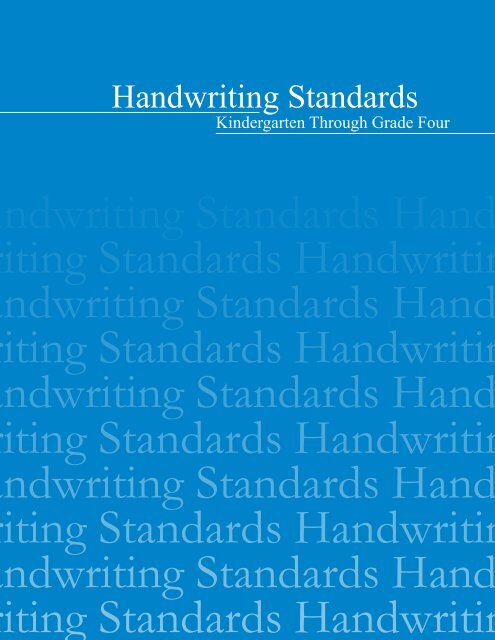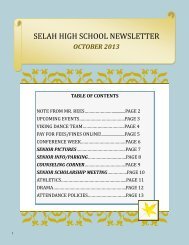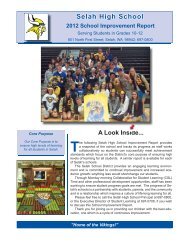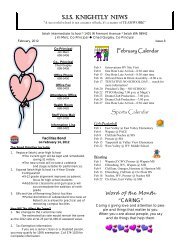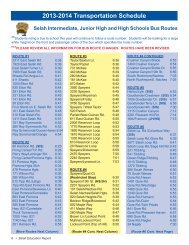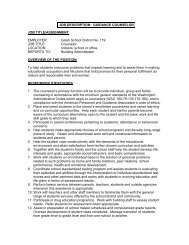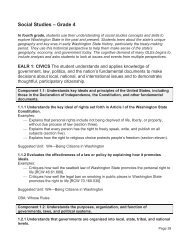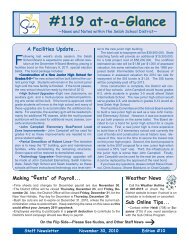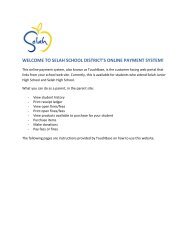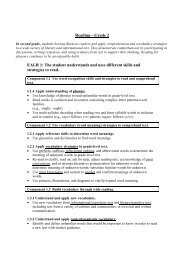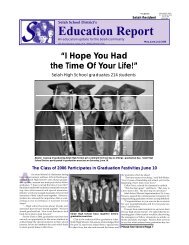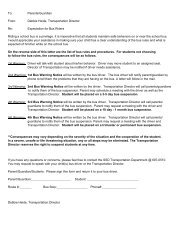Handwriting Standards - Selah School District
Handwriting Standards - Selah School District
Handwriting Standards - Selah School District
- No tags were found...
You also want an ePaper? Increase the reach of your titles
YUMPU automatically turns print PDFs into web optimized ePapers that Google loves.
<strong>Handwriting</strong> <strong>Standards</strong>Kindergarten Through Grade Fourndwriting <strong>Standards</strong> Handiting <strong>Standards</strong>Handwritinndwriting <strong>Standards</strong>Handiting <strong>Standards</strong>Handwritinndwriting <strong>Standards</strong>Handiting <strong>Standards</strong>Handwritinndwriting <strong>Standards</strong>Handiting <strong>Standards</strong>Handwritinndwriting <strong>Standards</strong>Handiting <strong>Standards</strong> Handwritin
Table of ContentsIntroduction................................................................................3Kindergarten...............................................................................4First Grade..................................................................................6Second Grade..............................................................................8Third Grade.............................................................................. 10Fourth Grade............................................................................. 12References................................................................................. 14
Introduction<strong>Handwriting</strong> is an essential skill for both children and adults (Feder & Majnemer, 2007). Even in the age oftechnology, handwriting remains the primary tool of communication and knowledge assessment for students in theclassroom. The demands for handwriting are great, whether in the classroom or beyond. A 1992 study (McHale &Cermak) found that 85 percent of all fine motor time in second-, fourth- and sixth-grade classrooms was spent onpaper and pencil activities. A more recent study (Marr, Cermak, Cohn & Henderson, 2003) noted that kindergartenchildren are now spending 42 percent of their fine motor time on paper and pencil activities. The addition ofhandwritten components to many state standardized assessments and of a handwritten essay to the College BoardSAT in 2005 further emphasize the importance of handwriting. Furthermore, good handwriting is important longafter graduation. In Script and Scribble (2009), Florey writes in reference to handwritten job applications, “Like it ornot, even in our machine-driven world, people still judge you by your handwriting.”Research literature extensively documents the consequences of poor handwriting on early literacy and academicperformance. Children who experience difficulty mastering this skill [handwriting] may avoid writing and decide thatthey cannot write, leading to arrested writing development (Graham, Harris and Fink, 2000). <strong>Handwriting</strong> is criticalto the production of creative and well-written text (Graham & Harris, 2005) affecting both fluency and the qualityof the composition. Illegible handwriting also has secondary effects on school achievement and self-esteem (Engel-Yeger, Nagakur - Yanuv & Rosenblum, 2009; Malloy-Miller, Polatajko & Anstett, 1995).<strong>Handwriting</strong> instruction must adhere to developmental principles to ensure success for all children. Accordingto the National Association for the Education of Young Children (NAEYC), newborn to eight-year-old childrenlearn best from methods that are consistent with developmentally appropriate practice (1996). However, due to ageneral lack in professional development in the area of handwriting, educators are not always aware of the specificobjectives to be addressed at various grade levels.<strong>Handwriting</strong> instruction must adhere to developmental principles to ensure success for all children. Yet educationalguidelines often are limited to one standard, “produces legible handwriting” in the English/Language Artsstandards. When students fail to meet this standard, teachers have no means for examining which skills are lacking.Meanwhile these students are experiencing all the negative effects of poor handwriting. Seeing the need for a morespecific analysis of skills, a team of occupational therapists and educators has developed this set of <strong>Handwriting</strong><strong>Standards</strong>. We hope it will serve as an example to educators and curriculum decision-makers and bring increasedattention to this crucial, yet often overlooked, area of education.© 2009 Jan Z. Olsen3
Kindergarten<strong>Handwriting</strong> <strong>Standards</strong>Readiness SkillsK.1 Concept DevelopmentStudents will demonstrate emergent literacy skills needed for writing. Each student will:A. Identify basic shapes (e.g., , , , )B. Recognize simple size differences (e.g., big and little)C. Understand position words (e.g., top/bottom, front/back, up/down, in/out)D. Demonstrate print awareness1. Position a book or page correctly for coloring, writing, or reading2. Track pictures, symbols, or letters from top to bottom and left to right3. Understand that printed words represent spoken wordsE. Identify printed symbols used for communication1. Identify capital letters2. Identify lowercase letters3. Identify numbersF. Use drawings and symbols to convey meaning and share ideas1. Draw simple shapes (e.g., , , , )2. Draw a person3. Use letters to approximate wordsK.2 Physical DevelopmentStudents will demonstrate physical development needed for writing. Each student will:A. Use a correct and efficient pencil grip for writingB. Stabilize paper with non-writing hand while drawing/writingC. Position writing paper appropriatelyD. Maintain sitting posture for writing/coloring/drawingPrinting SkillsK.3 Letter SkillsStudents will demonstrate skills in printing letters and numbers from memory. Each student will:A. Demonstrate correct formation of letters and numbers1. Start capital letters at the top2. Start numbers at the top3. Start lowercase letters (except d and e) at the top4. Follow standard formation sequence for letters and numbersB. Orient letters and numbers correctly (with few reversals)C. Place letters and numbers on a baseline (within 1/8″ above or below)D. Write letters and numbers in a grade-appropriate sizeE. Follow the writing guidelines of various styles of paper (triple, double, and single lines)4 © 2009 Jan Z. Olsen
K.4 Word SkillsStudents will write letters together to form words. Each student will:A. Write his/her name1. Begin with a capital letter2. Form each letter in a name, moving left to rightB. Write 2- to 5-letter words1. Form each letter in the word, moving left to right2. Use appropriate spacing (i.e., letters close together, NOT touching or overlapping)K.5 Sentence SkillsStudents write words to express thoughts, forming sentences. Each student will:A. Write simple 2- to 3-word sentencesB. Write horizontally, from left to rightC. Use sentence writing conventions:1. Start sentences with a capital letter2. Leave a clearly defined space between words3. Use ending punctuationa. Use period to end statementsb. Use a question mark to end questionsc. Use an exclamation point to end exclamations© 2009 Jan Z. Olsen5
1 st Grade<strong>Handwriting</strong> <strong>Standards</strong>Physical Skills1.1 Physical Approaches and Skill DevelopmentStudents will develop necessary physical skills for handwriting. Each student will:A. Use a correct and efficient pencil grip for writingB. Stabilize paper with non-writing hand while writingC. Position writing paper appropriatelyD. Maintain sitting posture for writingPrinting Skills1.2 Letter SkillsStudents will demonstrate skills in printing letters and numbers from memory. Each student will:A. Demonstrate correct formation of letters and numbers1. Start capital letters at the top2. Start numbers at the top3. Start lowercase letters (except d and e) at the top4. Follow standard formation sequence for letters and numbersB. Orient letters and numbers correctly (without reversals)C. Place letters and numbers on a baseline (within 1/16″ above or below)D. Write letters, numbers, and symbols in a grade-appropriate sizeE. Follow the writing guidelines of various styles of paper (triple, double, and single lines)1.3 Word SkillsStudents write letters together to form words. Each student will:A. Write names1. Begin each name with a capital2. Form each letter in a name, moving left to right3. Write courtesy titles correctly (Mr., Mrs., Ms., Miss., Dr.)4. Leave clearly defined space between title, first name, and last nameB. Write 2- to 7-letter words1. Form each letter in the word, moving left to right2. Use appropriate spacing (i.e., letters close together, NOT touching or overlapping)1.4 Sentence SkillsStudents write words to express thoughts, forming sentences. Each student will:A. Write 2- to 5-word sentencesB. Write from left to right, returning to left margin of subsequent lines as neededC. Use sentence writing conventions:1. Begin with a capital letter2. Leave a clearly defined space between words3. Use ending punctuation (period, question mark, or exclamation point)6 © 2009 Jan Z. Olsen
1.5 Writing ConventionsStudents will combine sentences to express ideas or opinions, using formatting conventions that are extensions ofhandwriting skills. Each student will:A. Copy/write a short paragraph1. Use three to five sentences2. Indent the first line of a paragraphB. Write titles of written works, capitalizing the first, last, and important words© 2009 Jan Z. Olsen7
2 nd Grade<strong>Handwriting</strong> <strong>Standards</strong>Physical Skills2.1 Physical Approaches and Skill DevelopmentStudents will demonstrate physical development needed for writing. Each student will:A. Use a correct and efficient pencil grip for writingB. Stabilize paper with non-writing hand while writingC. Position writing paper appropriatelyD. Maintain sitting posture for writingPrinting Skills2.2 Letter SkillsStudents demonstrate skills in printing letter and number skills from memory. Each student will:A. Demonstrate correct formation of letters and numbers1. Start capital letters at the top2. Start numbers at the top3. Start lowercase letters (except d and e) at the top4. Follow standard formation sequence for letters and numbersB. Orient letters and numbers correctly (without reversals)C. Place letters and numbers on a baseline (within 1/16″ above or below)D. Write letters, numbers, and symbols in a grade-appropriate sizeE. Follow the writing guidelines of various styles of paper (double and single lines)2.3 Word SkillsStudents write letters together to form words. Each student will:A. Write names1. Begin with a capital2. Form each letter in a name, moving left to right3. Write courtesy titles correctly (Mr., Mrs., Ms., Miss., Dr.)4. Leave clearly defined space between title, first name, and last nameB. Write 2- to 10-letter words1. Form each letter in the word, moving left to right2. Use appropriate spacing (i.e., letters close together, NOT touching or overlapping)3. Capitalize proper nouns4. Place apostrophe correctly in possessives and contractions5. End abbreviations with a period2.4 Sentence SkillsStudents write words to express thoughts, forming sentences. Each student will:A. Write sentences with two to eight wordsB. Write from left to right, returning to left margin of subsequent lines as needed8 © 2009 Jan Z. Olsen
C. Use sentence writing conventions:1. Begin with a capital letter2. Leave a clearly defined space between words3. Use ending punctuation (period, question mark, or exclamation point)D. Use comma and quotation marks to indicate speech2.5 Writing ConventionsStudents will combine sentences to express ideas or opinions, using formatting conventions that are extensions ofhandwriting skills. Each student will:A. Write paragraphs using proper conventions1. Write 3- to 5-sentence paragraphs2. Indent the first line of each paragraphB. Write titles of written works, capitalizing the first, last, and important wordsC. Follow standard format for friendly letters1. Write date, beginning at left margin or center of line2. Write greeting, beginning at left margin3. Write body, using paragraph skills4. Write closing, matching starting point of date5. Place name, matching starting point of date and closing© 2009 Jan Z. Olsen9
3 rd Grade<strong>Handwriting</strong> <strong>Standards</strong>Pre-Cursive Skills3.1 Preparation SkillsStudents will demonstrate strokes needed for cursive handwriting: strokes that change direction, retrace lines,or form loops. Each student will:A. Connect an under to an over stroke, moving left to rightB. Retrace a vertical strokeC. Retrace a curved strokeD. Produce neat loops (ascending and descending)Cursive Skills3.2 Letter SkillsStudents will demonstrate cursive writing skills efficiently from memory. Each student will:A. Form lowercase letters correctlyB. Form capital letters correctlyC. Place letters on a baseline (within 1/16″ above or below)D. Write letters in a grade-appropriate sizeE. Follow the writing guidelines of various styles of paper (double and single lines)3.3 Connection SkillsStudents will join letters to form words, using standard, efficient connections. Each student will:A. Demonstrate correct baseline connections, maintaining letter integrity1. Connect baseline ending to a baseline start (e.g., t to e)2. Connect baseline ending to a midline start (e.g., c to a)B. Demonstrate correct high connections, maintaining letter integrity1. Connect a high ending to a midline start (e.g., o to u)2. Connect a high ending to a baseline start (e.g., w to h, b to r)C. Use appropriate spacing between connected letters (close together, NOT overlapping, with onlyconnections touching)D. Cross and dot appropriate letters after completing connected lettersE. Demonstrate correct connections from capital letters1. Write signature in cursive using correct connections2. Use correct connections for proper nouns3.4 Sentence SkillsStudents will write words to express thoughts, forming sentences. Each student will:A. Write from left to right, returning to left margin of subsequent lines as neededB. Use sentence writing conventions:1. Begin with a capital letter2. Leave a clearly defined space between words3. Use ending punctuation (period, question mark, or exclamation point)C. Use comma and quotation marks correctly to indicate speechD. Use commas to separate items in series and to set off clauses and phrases10 © 2009 Jan Z. Olsen
3.5 Writing ConventionsStudents will combine sentences to express ideas or opinions, using formatting conventions that are extensions ofhandwriting skills. Each student will:A. Write paragraphs using proper conventions1. Write 5- to 6-sentence paragraphs2. Indent the beginning of each paragraphB. Write titles of written works, capitalizing the first, last, and important wordsC. Follow standard format for friendly letters1. Write date, beginning at left margin or center of line2. Write greeting, beginning at left margin3. Write body using paragraph skills4. Write closing, matching starting point of date5. Place signature, matching starting point of date and closing© 2009 Jan Z. Olsen11
4 th Grade<strong>Handwriting</strong> <strong>Standards</strong>Pre-Cursive Skills4.1 Preparation SkillsStudents demonstrate strokes needed for cursive handwriting: strokes that change direction, retrace lines, orform loops. Each student will:A. Connect an under to an over stroke, moving left to rightB. Retrace a vertical strokeC. Retrace a curved strokeD. Produce neat loops (ascending and descending)Cursive Skills4.2 Letter SkillsStudents demonstrate cursive writing skills efficiently from memory. Each student will:A. Form lowercase letters correctlyB. Form capital letters correctlyC. Place letters on a baseline (within 1/16″ above or below)D. Write letters in a grade-appropriate sizeE. Follow the writing guidelines of various styles of paper (single lines)4.3 Connection SkillsStudents join letters using standard, efficient connections to form words. Each student will:A. Demonstrate correct baseline connections, maintaining letter integrity1. Connect baseline ending to baseline start (e.g., t to e)2. Connect baseline ending to midline start (e.g., c to a)B. Demonstrate correct high connections, maintaining letter integrity1. Connect a high ending to midline start (e.g., o to u)2. Connect a high ending letter to baseline start (e.g., w to h, b to r)C. Use appropriate spacing between connected letters (close together, NOT overlapping with onlyconnections touching)D. Cross and dot appropriate letters after completing connected lettersE. Demonstrate correct connections from capital letters1. Write signature in cursive using correct connections2. Use correct connections for proper nouns4.4 Sentence SkillsStudents will write words to express thoughts, forming sentences. Each student will:A. Write from left to right, returning to left margin of subsequent lines as neededB. Use sentence writing conventions:1. Begin with a capital letter2. Leave a clearly defined space between words3. Use ending punctuation (period, question mark, or exclamation point)C. Use comma and quotation marks correctly to indicate speechD. Use commas to separate items in series and to set off clauses and phrases12 © 2009 Jan Z. Olsen
4.5 Writing ConventionsStudents will combine sentences to express ideas or opinions, using formatting conventions that are extensions ofhandwriting skills. Each student will:A. Write paragraphs using proper conventions1. Write 5- to 6-sentence paragraphs2. Indent the beginning of each paragraphB. Write titles of written works, capitalizing the first, last, and important wordsC. Follow standard format for business letters1. Write heading (return address and date) at left margin2. Write inside address at left margin3. Write salutation at left margin4. Write body using paragraph skills, leaving line space between paragraphs5. Write closing at left margin6. Place signature at left margin7. Leave line space after heading, inside address, salutation, body, closing© 2009 Jan Z. Olsen13
ReferencesEngel-Yeger, B., Magauker-Yanuv, L., & Rosenblum, S. (2009). <strong>Handwriting</strong> Performance, Self Reports, andPerceived Self-Efficacy Among Children with Dysgraphia. American Journal of Occupational Therapy, 63,182-190.Feder, K.P., & Majnemer, A. (2007). <strong>Handwriting</strong> development, competency, and intervention. DevelopmentalMedicine & Child Neurology, 49, 312-317.Florey, Kitty Burns (2009). Script and Scribble: The Rise and Fall of <strong>Handwriting</strong>. NewYork: Melville HousePublishing.Graham, S. & Harris, K.R., (2005). Improving the writing performance of young struggling writers. The Journal ofSpecial Education, 39, 19-33.Graham, S., Harris, K.R., & Fink, B. (2000). Extra handwriting instruction: prevent writing difficulties right from thestart. Teaching Exceptional Children, 33, 88-92.Malloy-Miller, T., Polatajko, H., & Ansett, B. (1995). <strong>Handwriting</strong> error patterns of children with mild motordifficulties. Canadian Occupational Therapy Journal, 62, 258-267.Marr, D., Cermack, S.A., Cohn, E.S, & Henderson, A. (2003). Fine motor activities in Head Start and Kindergartenclassrooms. American Journal of Occupational Therapy 57, 550-557.McHale, K., & Cermack, S.A. (1992) Fine Motor activities in elementary school: preliminary findings andprovisional implications for children with fine motor problems. American Journal of Occupational Therapy,46, 898-903.NAEYC. 1996. NAEYC position statement: Developmentally appropriate practice in early childhood programsserving children from birth through age eight. Washington DC: Author. Retrieved December 2, 2007, fromhttp://www.naeyc.org/about/positions/pdf/PSDAP98.PDF14 © 2009 Jan Z. Olsen


